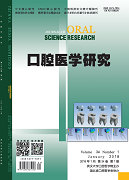|
|
Expression and Significance of Vitronectin in Blood Serum of Oral Squamous Cell Carcinoma
TIAN Bing, HU Teng-long, JING Guang-ping, YU Yang, ZHONG Ke-tao, WANG Hai-tao, YU Qing
2018, 34(1):
44-46.
DOI: 10.13701/j.cnki.kqyxyj.2018.01.011
Objective: To observe the expression of blood serum vitronectin (VTN) in oral squamous cell carcinoma (OSCC), and to explore its clinical significance and the degree of differentiation, as well as the correlation between cervical lymph node metastasis. Methods: Western blot method was used to detect VTN expression in 26 OSCC patients without lymph node metastasis, including 18 OSCC patients with lymph node metastasis, 8 oral tissue atypical hyperplasia patients, 20 healthy people from Department of Oral and Maxillofacial Surgery, affiliated Stomatological Hospital of Harbin Medical Universit from 2016,08,01-2017,05,30. Results: VTN was highly expressed in the blood serum of healthy people (36849.10±1127.37) than that of OSCC patients without lymph node metastasis (22518.12±1301.25). VTN was also highly expressed in the blood serum of OSCC patients without lymph node than that of OSCC patients with lymph node metastasis (9459.28±629.58, P<0.001). VTN was 36725.50±1484.41 in the blood serum of patients with atypical hyperplasia of oral mucosa. The expression of VTN in OSCC patients with different differentiated degree and without lymph node metastasis was analyzed. The results showed that VTN was highly expressed in the blood serum of high differentiated OSCC patients (59009.13±145.75) than that of moderately differentiated OSCC patients (39468.82±1135.61). And its expression was also higher than that of poorly differentiated OSCC patients (22437.00±1286.38, P<0.001). Conclusion: VTN may be associated with the malignant transformation and mestastasis of OSCC, and expression of serum VTN may help OSCC diagnosis and disease progression assessment.
References |
Related Articles |
Metrics
|

